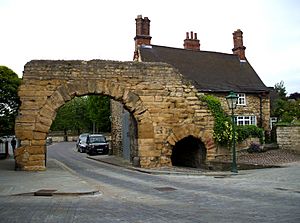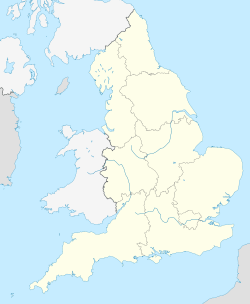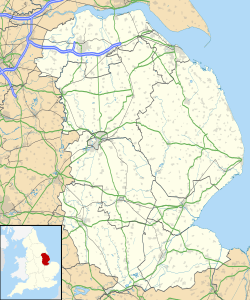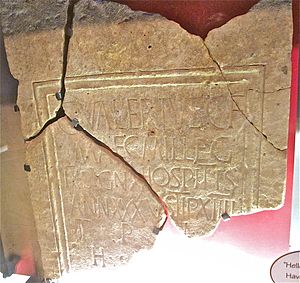Lindum Colonia facts for kids

The Newport Arch is a surviving part of the north gate to the Upper City.
|
|
| Alternative name | Lindum, Colonia Domitiana Lindensium |
|---|---|
| Location | Lincoln, Lincolnshire, England |
| Region | Britannia |
| Coordinates | 53°14′02″N 00°32′17″W / 53.23389°N 0.53806°W |
| Type | Settlement |
| History | |
| Builder | Domitian |
| Founded | Around 80 AD |
| Abandoned | End of the 5th century |
| Periods | Roman Imperial |
Lindum Colonia was the Roman name for the city we now call Lincoln in Lincolnshire, England. It started as a strong Roman army camp, or "fortress," around 60 AD. This camp was first used by the Ninth Legion, then later by the Second Legion.
Around 86 AD, the army camp became a "colonia." This was a special settlement for Roman soldiers who had retired. The city grew, adding a "Lower Colonia" near the River Witham. Important buildings like a forum (a public square), baths, and shops were built.
The city was protected by strong walls. The walls for the "Upper Colonia" were built in the early 2nd century. The "Lower Colonia" got its walls later, around the late 2nd or early 3rd century. By the early 3rd century, Lindum Colonia might have even become a capital city for a Roman province called Britannia Secunda.
In the 4th century, the city continued to grow. There is also more evidence that Christianity was becoming important here. After the Romans left Britain in the 5th century, Lindum Colonia became smaller. However, some people still lived there, showing that the city didn't completely disappear.
Contents
What's in a Name?
The name Lindum comes from an old British word, Lindon. This word probably meant "pool" or "lake." This makes sense because Lincoln is near a large natural pool formed by the River Witham.
Ancient Roman maps and travel guides mention Lindum. For example, Ptolemy's ''Geography'', written around 150 AD, calls it a "polis" or town. The Antonine Itinerary, a Roman road map, also lists Lindum several times.
Later, in the 7th century, a document called the Ravenna Cosmography called it Lindum Colonia. This shows it was a "colonia," a special Roman town for retired soldiers. It's thought that the full name might have been Colonia Domitiana Lindensium, named after Emperor Domitian. However, we haven't found any Roman writings that fully confirm this name.
History of Lindum Colonia
Building the Roman Fortress
The Romans took control of this part of Britain around 48 AD. Soon after, they built a military fortress. This first fortress might have been south of the River Witham.
Around 60 AD, a new, stronger fort was built. This one was for the Ninth Legion. It was built high on a hill, looking over the large lake formed by the River Witham. This lake is now called the Brayford Pool. This location was also at the northern end of the Fosse Way, an important Roman road. The lake likely gave Lincoln its name.
Changes Over Time
After the Romans left, the city and its waterways slowly declined. By the end of the 5th century, most people had left. However, one church, St Paul's, continued to be used. Its churchyard was even used into the 6th century.
When Saint Paulinus visited in 629 AD, a leader named Blecca was in charge. Old church buildings were found in the center of the Roman forum. This suggests that Lincoln was not completely empty. It seems Lincoln kept its important role in the area. This area later became the Kingdom of Lindsey during the Anglo-Saxon period.
City Life and Infrastructure
Roman Water Supply
Roman Lincoln had a very clever way of getting water. Water came from a spring called "Roaring Meg" northeast of the city. It flowed through ceramic pipes towards the city's northeast corner.
These pipes were covered in concrete. This made them waterproof and allowed water to flow under pressure. People have known about this water system since the 1700s. Old maps and drawings show where the aqueduct ran.
Archaeologists found the base for a water tank inside the Roman wall. This tank was near the Newport Arch. It likely supplied water to a Roman bathhouse nearby. Another pipeline was found that probably carried water to the "Lower Colonia."
Engineers calculated that the water needed to be raised about 70 feet at the spring. This would create enough pressure for it to reach the city. This means the Romans likely used some kind of water tower or pump system.
For a long time, people wondered if the aqueduct actually worked. This was because no mineral deposits (like limescale) were found in the pipes. But in 2007, new discoveries showed limescale. This proved that the aqueduct was indeed used to bring water to Lindum Colonia.
Industry in Roman Lincoln
Making Pottery
Lincoln was an important place for making pottery. The first pottery oven, or "kiln," was found at what is now Lincoln College. This kiln made special bowls called Mortaria. These bowls were stamped with the potter's name, VITALIS, who worked around 90-115 AD.
More kilns were found later, making different types of pottery. For example, kilns at Swanpool made gray storage jars. Others at Lincoln Racecourse made more Mortaria. Potters like CATTO made bowls and decorated pottery north of Lincoln.
In the 3rd and 4th centuries, Lincolnshire produced a type of pottery called Dales ware. This pottery was sold and used all over northern Roman Britain.
Roman Sculptures and Tombstones
|
See also
 In Spanish: Lindum Colonia para niños
In Spanish: Lindum Colonia para niños











